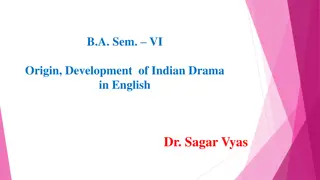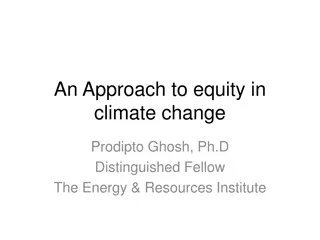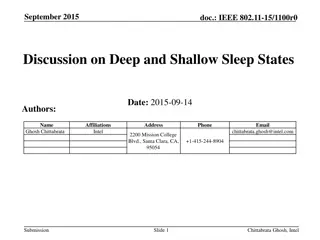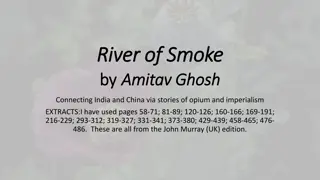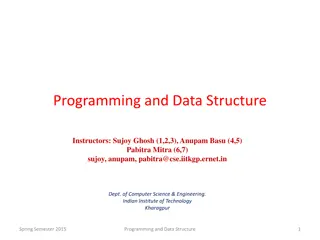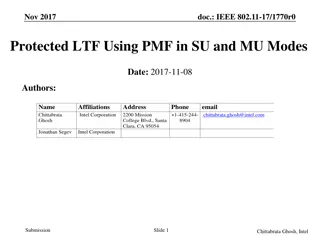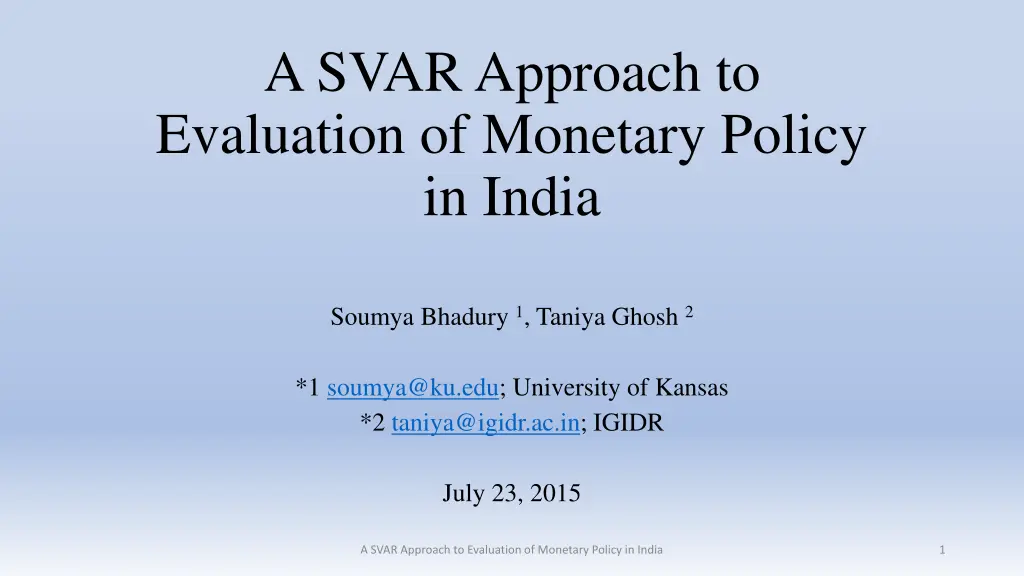
Evaluation of Monetary Policy in India: SVAR Approach
"Explore the SVAR approach for assessing monetary policy in India, integrating money into the system alongside interest rates. Discover the importance of including money in policy evaluation and its implications for the Indian economy."
Download Presentation

Please find below an Image/Link to download the presentation.
The content on the website is provided AS IS for your information and personal use only. It may not be sold, licensed, or shared on other websites without obtaining consent from the author. If you encounter any issues during the download, it is possible that the publisher has removed the file from their server.
You are allowed to download the files provided on this website for personal or commercial use, subject to the condition that they are used lawfully. All files are the property of their respective owners.
The content on the website is provided AS IS for your information and personal use only. It may not be sold, licensed, or shared on other websites without obtaining consent from the author.
E N D
Presentation Transcript
A SVAR Approach to Evaluation of Monetary Policy in India Soumya Bhadury1, Taniya Ghosh 2 *1 soumya@ku.edu; University of Kansas *2 taniya@igidr.ac.in; IGIDR July 23, 2015 A SVAR Approach to Evaluation of Monetary Policy in India 1
A SVAR Approach to Evaluation of Monetary Policy in India Introduction and Motivation The Structural VAR model Empirical Result Conclusion A SVAR Approach to Evaluation of Monetary Policy in India 2
A SVAR Approach to Evaluation of Monetary Policy in India Introduction and Motivation The Structural VAR model Empirical Result Conclusion A SVAR Approach to Evaluation of Monetary Policy in India 3
The Basic Tenets of the Model In majority of the exchange rate literature, interest rate alone plays the role of the monetary policy instrument We try to introduce separately money into the system, other than interest rate Our novelty will lie in introducing the theoretically grounded, superlative measure of money i.e. Divisia monetary aggregate We introduce the K&R contemporaneous restrictions customized for the Indian economy A SVAR Approach to Evaluation of Monetary Policy in India 4
Why Interest rate the only monetary policy instrument? Chrystal and McDonald (1995) claim that the velocity of the monetary aggregate in some major countries like U.S.A and U.K., took a sharp downward trend after 1980 ** (See Stone and Thronton, 1987) Leeper and Roush (2003) agree with C&M that traditionally stable money demand functions were widely perceived to have broken down A SVAR Approach to Evaluation of Monetary Policy in India 5
Why include Money? Ireland finds money plays an informational-role rather than causal-role by helping to forecast future nominal rate of interest**(Ireland 2001a,2001b) Practical consideration suggests including money in the Central Bank s policy rule Goodfriend (1999) argues that money plays a critical role even under an interest rate policy because credibility for a price-path objective stems from a central bank s power to manage a stock of money A SVAR Approach to Evaluation of Monetary Policy in India 6
Why include Divisia Money? Divisia money measures the aggregate flow of the monetary services derived from a collection of assets that are imperfect substitutes**(Barnett, 1980) C&M (1995) believe that in a period of rapid financial liberalization data dynamics will be unable to track the exchange rate movements when simple-sum money is the preferred monetary aggregate Relative performance of Divisia over simple-sum has been evaluated in forecasting inflation**( Schunk, 2001; Drake and Mills, 2005; Stock and Watson,1999) We believe Divisia correctly tracks the flow of money services; plays an informational role critical to capturing exchange rate movements and determination. A SVAR Approach to Evaluation of Monetary Policy in India 7
Indian economy at a glance Indian economy experienced high inflation in last 24 years Monetary policy stance loosened overtime Simple-sum M1 & M3 growth shows significant liquidity injection in the Indian economy Divisia measure shows that simple-sum over-estimates liquidity injection Industrial growth stagnated post 2007 A SVAR Approach to Evaluation of Monetary Policy in India 8
Introduction and Motivation The Structural VAR model Empirical Result Conclusion A SVAR Approach to Evaluation of Monetary Policy in India 9
Model ?0??= ? + ?1?? 1+ ?2?? 2 + + ???? ?+ ??is the structural model ?? is an ? 1 data vector, ? is an ? 1 data vector of constants ?? is an ? 1 structural disturbances vector and is serially and mutually uncorrelated. ? denotes the number of lags. ??= [ (???/????)? ????? ???? ?? ??? ??? ???] A SVAR Approach to Evaluation of Monetary Policy in India 10
Model ??= ? + 1?? 1+ 2?? 2 + + ??? ?+ ?? is the reduced form model ?? is the reduced form residuals ??= ?0?? ??= [?? ???/???? ?? ???? ?? ??? ??? ???? ???? ????] It is possible to recover the structural parameters from the reduced form model It requires the model be either exactly identified or over-identified A SVAR Approach to Evaluation of Monetary Policy in India 11
Structural Shocks VAR can be written in terms of the structural shocks World oil price shock/ World commodity price shock Foreign interest rate shock Domestic output shock Inflation or cost push shock Money demand shock Monetary policy shock Exchange rate shock A SVAR Approach to Evaluation of Monetary Policy in India 12
Identification Assumptions A SVAR Approach to Evaluation of Monetary Policy in India 13
Identification Assumptions Contemporaneously exogenous world shock variable (alternatively captured using the world commodity price index and world price index) The foreign interest rate is the Fed fund rate, the short term interest rate of the U.S. , in the small open economy framework is only affected by the world event shocks Output and prices do not respond contemporaneously to changes in domestic monetary policy variables and exchange rates. Real activity like the industrial production responds to domestic price and financial signals (interest rate and exchange rate) with a lag The industrial production and inflation of the small, open, economy is deeply impacted by the world or outside shocks A SVAR Approach to Evaluation of Monetary Policy in India 14
Identification Assumptions Inflation is affected by the world shock and the current state of industrial production. In addition to the real income and the domestic interest rate, the money demand function also depends on the foreign (US) interest rate and the prevailing exchange rates Monetary policy i.e. interest rate is set after observing the current value of money supply, the interest rate and the exchange rate Exchange rate is one of the most volatile variables in the model and is quick to react to almost all shocks be it from inside or outside, be it nominal or real variable shock. A SVAR Approach to Evaluation of Monetary Policy in India 15
Monetary Aggregates M2 = currency with the public + demand deposits with banks + other deposits with the RBI + time liability proportion of the savings deposits with banks + term deposits with the contractual maturity of up to and including one year with banks + certificate of deposits issued by banks M3 = M2 + term deposits with the contractual maturity of over one year with banks + call borrowings from non-depository financial corporations by banks L1 = M3 + all deposits with the Post Office Savings Banks (excluding National Savings Certificates) A SVAR Approach to Evaluation of Monetary Policy in India 16
Model Structure Table 1 SVAR Model [Non-Recursive (NR) Structure] {oilp, rfed, iip, pi, dm3, rdom, er} {oilp, rfed, iip, pi, m3, rdom, er} {oilp, rfed, iip, pi, m1, rdom, er} {oilp, rfed, iip, pi, dl1, rdom, er} {oilp, rfed, iip, pi, dm2, rdom, er} {wcom, rfed, iip, pi, dm3, rdom, er} {wcom, rfed, iip, pi, m3, rdom, er} {wcom, rfed, iip, pi, m1, rdom, er} {wcom, rfed, iip, pi, dl1, rdom, er} {wcom, rfed, iip, pi, dm2, rdom, er} Model 1 Model 2 Model 3 Model 4 Model 5 Model 6 Model 7 Model 8 Model 9 Model 10 (NR, OIL, DM3) (NR, OIL, M3) (NR, OIL, M1) (NR, OIL, DL1) (NR, OIL, DM2) (NR, COM, DM3) (NR, COM, M3) (NR, COM, M1) (NR, COM, DL1) (NR,COM,DM2) VAR Models with Cholesky Decomposition[Recursive (R) Structure] {oilp, rfed, iip, pi, dm3, rdom, er} {oilp, rfed, iip, pi, m3, rdom, er} {oilp, rfed, iip, pi, m1, rdom, er} {oilp, rfed, iip, pi, dl1, rdom, er} {oilp, rfed, iip, pi, dl1, rdom, er} Model 11 Model 12 Model 13 Model 14 Model 15 (R, OIL, DM3) (R, OIL, M3) (R, OIL, M1) (R, OIL, DL1) (R, OIL, DM2) Model 16 {oilp, rfed, iip, pi, rdom, er} (R,OIL, X) A SVAR Approach to Evaluation of Monetary Policy in India 17
A SVAR Approach to Evaluation of Monetary Policy in India Introduction and Motivation The Structural VAR model Empirical Result Conclusion A SVAR Approach to Evaluation of Monetary Policy in India 18
Model and Puzzles Table 2 Price puzzle is a phenomenon where a contractionary monetary policy shocks identified with an increase in interest rates, leads to a persistent rise in price level instead of a reduction of it. Model & Code Liquidity Puzzle Price Puzzle Exchange Rate Puzzle Forward Discount Bias Puzzle 1 (NR,OIL,DM3) none None None None 2 (NR,OIL,M3) Insignificant None None None 3 (NR,OIL,M1) Yes Yes None None The liquidity puzzle is an empirical finding when a money market shock is associated with increases in the interest rate instead of a decrease. 4 (NR,OIL,DL1) none None None None 5 (NR,OIL,DM2) none None None None 6(NR,COM,DM3) none none None None 7 (NR,COM,M3) Insignificant Insignificant None None The exchange rate puzzle occurs when a restrictive domestic monetary policy leads to on impact depreciation of domestic currency. 8 (NR,COM,M1) Insignificant None None None 9 (NR,COM,DL1) Insignificant Insignificant None None 10(NR,COM,DM2) Insignificant None None None 11 (R,OIL,DM3) Yes Yes None Yes 12 (R,OIL,M3) Insignificant Yes Yes Yes Or, if it appreciates, it does so for a prolonged period of time violating the uncovered interest parity condition which is known as the forward discount bias puzzle or delayed overshooting. 13 (R,OIL,M1) None Yes Yes Yes 14 (R,OIL,DL1) Yes Yes None Yes 15 (R,OIL,DM2) Yes Yes None Yes 16 (R,OIL,X) Yes Yes Yes Yes A SVAR Approach to Evaluation of Monetary Policy in India 19
Impulse Response Functions in a Recursive model Depreciation of the currency and persistent depreciation thereafter (exchange rate puzzle and forward discount bias puzzle) following monetary policy shock Persistent rise in inflation (price puzzle) from a monetary policy shocks. contractionary A SVAR Approach to Evaluation of Monetary Policy in India 20
Impulse Response Function in a Non-Recursive model We observe thatSVAR models generally doing way better than the recursive models Models with Divisia monetary aggregates (DM3) are doing better than simple-sum monetary aggregate (M3) Divisia aggregates (Divisa L1, Divisia M2 etc.) did better than their simple-sum counterparts not shown here A SVAR Approach to Evaluation of Monetary Policy in India 21
Impulse Response Function in a Non-Recursive model A SVAR Approach to Evaluation of Monetary Policy in India 22
Variance Decomposition Table 3 Model 10 with world price of commodities and Divisia M2 works the best Forecast Error Decomposition: Contribution of Monetary Policy Shocks to Exchange Rate Variation (in percentages) Month Model 1(DM3) Model 2(M3) Model 10(DM2) Between all the Divisia aggregates, DM2 consistently works better than DL1 and DM3 1 15.968 5.706 28.417 2 17.104 5.453 29.890 3 19.67 7.51 33.094 Narrow simple-sum aggregate (M1) consistently worked better compared to M3 10 14.954 6.786 25.158 11 14.354 6.317 24.007 12 13.945 5.935 22.667 Divisia M3 consistently helps monetary policy better explain fluctuation in the exchange rate compared to its simple sum counterpart 22 10.993 4.635 17.974 23 10.378 4.602 17.468 24 9.773 4.583 17.053 A SVAR Approach to Evaluation of Monetary Policy in India 23
Flip-flop analysis Top panel represents the fluctuation in the fundamental variables (exchange rate, inflation and economic activity) that are being explained by the policy variable. Monetary policy is able to explains exchange rate fluctuations the most, followed by prices and the least for industrial production due to weak transmission Bottom panel represents how much of the same fundamental variables are able to explain the movement in the policy variable. Central bank in India seems to set the monetary policy rule with inflation-targeting in mind. A SVAR Approach to Evaluation of Monetary Policy in India 24
Forecast statistics: Theil U and RMSE Model with Divisia M3 records a lower RMSE and Theil U values, when compared with the model with simple- sum M3 Table 4 RMSE (DM3) RMSE (M3) Theil U (DM3) Theil U (M3) STEP 1 0.016817268 0.0168186 0.9407059 0.940740 2 0.027939798 0.0279426 0.9465474 0.946622 The difference between the RMSE and Theil U for the different aggregate grows over time 4 0.04509268 0.045096935 0.97101692 0.97110852 8 0.081620156 0.081625622 1.02052515 1.02059349 16 0.135008923 0.135019462 1.05461511 1.05469744 20 0.130837069 0.130854786 1.06003547 1.06017902 This might be because Divisia M3 facilitates longer-horizon forecasting. 22 0.118076898 0.118096956 1.07450819 1.07469072 24 0.08290196 0.082923123 1.13793843 1.13822892 A SVAR Approach to Evaluation of Monetary Policy in India 25
Forecast statistics: Out-of-Sample forecast Figure compares between the model without money and model with the Divisia M3 The forecast with no money is represented in blue diverges from actual value over time. The forecast with Divisia M3 (represented in coral) stays closer to the actual log of exchange rate value (represented in black) Forecast band for the Divisia M3 (represented in pink) lies within the forecast band for the no money (represented in green) A SVAR Approach to Evaluation of Monetary Policy in India 26
Forecast statistics: Out-of-Sample forecast Figure compares between the model with simple-sum M3 and model with the Divisia M3 Divisia M3 forecast (represented in coral) stays closer to the actual LER value (represented in black) Simple-sum M3 forecast (represented in blue) diverges from actual value over time. Divisia M3 (represented in pink) has narrower forecast band compared to simple-sum M3 (represented in green) reflecting higher forecast accuracy for Divisia. A SVAR Approach to Evaluation of Monetary Policy in India 27
A SVAR Approach to Evaluation of Monetary Policy in India Introduction and Motivation The Structural VAR model Empirical Result Conclusion A SVAR Approach to Evaluation of Monetary Policy in India 28
Conclusion K&R contemporaneous restriction customized for the Indian economy showed mostly puzzle-free results In order to claim this with confidence, we compared the contemporaneous SVAR with the recursive model SVAR model was able to get rid of the price puzzle and the exchange rate puzzle Existence of output-puzzle due to weakly developed financial market impeding monetary transmission The Variance Decomposition showed Divisia money rightly captures the information on flow of monetary services Alternatively, money has an informational role to play in our model which gets clear when we compared across no-money, model with simple-sum and model with Divisia aggregate A SVAR Approach to Evaluation of Monetary Policy in India 29
Conclusion We did the out-of-sample forecasting, across simple-sum monetary models and Divisia money models In general, the inclusion of money lowered the RMSE values and Divisia M3 money model did fairly better than simple-sum M3 model Finally, the flip-flop analysis showed, monetary policy explains most of exchange rate fluctuation, followed by inflation and least of the output movements Alternatively, inflation is able to explain the most of the policy variable changes, followed by exchange rate and output, switching over from time to time This leads us to believe that the Central Bank of India had inflation-targets in mind, when it set up its policy rates. A SVAR Approach to Evaluation of Monetary Policy in India 30

